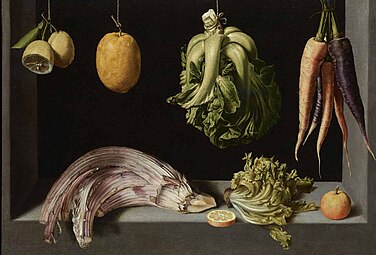Bodegón

The term bodega in Spanish can mean "pantry", "tavern", or "wine cellar". The derivative term bodegón is an augmentative that refers to a large bodega, usually in a derogatory fashion. In Spanish art, a bodegón is a still life painting depicting pantry items, such as victuals, game, and drink, often arranged on a simple stone slab, and also a painting with one or more figures, but with significant still life elements, typically set in a kitchen or tavern. It also refers to low-life or everyday objects, which can be painted with flowers, fruits, or other objects to display the painter's mastery.[1]
History
[edit]
Beginning in the Baroque period, such paintings became popular in Spain in the second quarter of the 17th century. The tradition of still life painting appears to have started and was far more popular in the contemporary Flemish and Dutch artists (Belgium and Netherlands today), than in southern Europe. Northern still lifes had many subgenres; the breakfast piece was augmented by the trompe-l'œil, the flower bouquet, and the vanitas. In Spain there were much fewer patrons for this sort of thing, but a type of breakfast piece did become popular, featuring a few objects of food and tableware laid on a table. Though now considered a Spanish invention, the classic trompe-l'œil presentation of fruit on a stone slab was common in ancient Rome.
Spanish Baroque still life painting were often austere; they differed from the Flemish Baroque still lifes, which often contain both rich banquets surrounded by ornate and luxurious items with fabric or glass. In bodegones, the game is often plain dead animals still waiting to be skinned. The fruits and vegetables are uncooked. The backgrounds are bleak or plain wood geometric blocks, often creating a surrealist air. Both Netherlandish and Spanish still lifes often had a moral vanitas element. Their austerity, akin to the bleakness of some of the Spanish plateaus, never copies the sensual pleasures, plenitude, and luxury of many Northern European still life paintings.
The Velázquez paintings The Waterseller of Seville, Old Woman Frying Eggs, and The lunch are often described as bodegones[2][3] due to the artist's depiction of jars and foodstuff. Some people reject this use of the term, calling them instead a mixture of genre painting in Bamboccianti style and still life.[citation needed]
Motifs
[edit]-
Vegetables and fruits, some suspended by thread.
Still Life with Fruits and Vegetables by Juan Sánchez Cotán; c. 1600, 69 × 96 cm, private collection. -
Bodegón with elements of genre paintings — kitchen and cooking.
An Old Woman Cooking Eggs by Diego Velázquez; 1618, 101 × 120 cm, Scottish National Gallery. -
Carved meat, eggs, and utensils.
Kitchen Still Life by Alejandro de Loarte; c. 1626, 82 × 108 cm, private collection. -
Sweets, pottery, glassware, and wooden containers.
Still Life with Sweets and Pottery by Juan van der Hamen; 1627, 85 × 113 cm, National Gallery. -
Bodegón with a religious theme — Lamb of God.
Agnus Dei by Francisco de Zurbarán; 1635–40, 37 × 62 cm, Prado Museum. -
Flower vase and fruit bowl.
Still Life with Flowers in a Vase and a Fruit Bowl on a Ledge by Antonio Ponce; 1640–60, 62 × 100 cm, private collection. -
Furniture, delftware, maiolica, and ceramics.
Still Life with an Ebony Chest by Antonio de Pereda; c. 1652, 80 × 94 cm, Hermitage Museum. -
Baked food, metallic kitchenware, and fruits on branches.
Still Life by Tomás Yepes; 1668, 102 × 157 cm, Prado Museum. -
Cheese, barrel, glass bottle, fruits in decorative plate, storage jars and boxes.
Still Life with Fruit and Cheese by Luis Egidio Meléndez; 1771, 41 × 62 cm, Prado Museum. -
Fish and allegorical allusions — to The Disasters of War.
Still Life with Golden Bream by Francisco Goya; 1808, 45 × 63 cm, Museum of Fine Arts, Houston. -
Pantry shelf, pitchers, and hunted game — various birds and hares.
Kitchen Still Life with Game and Vegetables by José María Corchón; 1850–55, 140 × 187 cm, Prado Museum.
References
[edit]- ^ Johnson, Paul. Art: A New History, Weidenfeld & Nicolson, 2003, p. 353.
- ^ Encyclopædia Britannica article on Velasquez does so.
- ^ As does this dictionary of art terms: Lucie-Smith, Edward (1984). The Thames and Hudson Dictionary of Art Terms. London: Thames and Hudson. p. 32. ISBN 9780500233894. LCCN 83-51331
Bibliography
[edit]- Jordan, William B. (1985). Spanish Still Life in the Golden Age, 1600–1650. Fort Worth: Kimbell Art Museum. ISBN 978-0-912804-19-4.
- Jordan, William B.; Cherry, Peter (1995). Spanish Still Life from Velázquez to Goya. London: National Gallery. ISBN 978-1-85709-064-2.
- Nochlin, Linda' The Politics of Vision : Essays on Nineteenth-Century Art and Society. New York: Harper & Row, (1989). Page 30.
- JC Robinson: The Bodegones and Early Works of Velázquez, The Burlington Magazine for Connoisseurs,1906, page 172.












